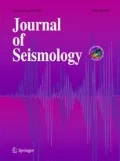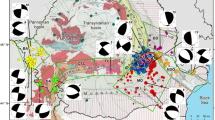Abstract
The 2010 Efpalion seismic sequence with two main moderate earthquake events occurred in the northwestern part of the Corinth Gulf (Central Greece)—a region that has been intensely stretched due to an on-going N–S extensional stress regime. Previous studies assign these two events to activations of (a) two faults dipping to the north with low angles; (b) two faults dipping at high angles, the first dipping to the south, and the second to the north; and (c) two faults dipping at high angles, but the first dips to the north, and the second to the south. The recently proposed TR method for focal mechanisms that identifies the seismogenic fault of an earthquake sequence is applied on the available focal mechanisms of the sequence, and its results are interrelated with the geology of the region, and previous contradictory interpretations. The focal mechanisms constructed with MT inversion define a steep north-dipping normal fault, whereas those constructed with first motions of P-waves define the activation of two adjoining faults that dip with high angles to the SSE and south, respectively, and which are characterized by strain (slip) compatibility. The latter option fits well with the geology of the region that is dominated by a SE to S-dipping horse-tail splay fault zone which exists at the eastern tip of the Nafpaktos Mountain Front. The application of the TR method reveals that the usage itself of different methods for the construction of the focal mechanisms complicates the problem of correctly identifying the seismogenic fault.







Similar content being viewed by others
References
Angelier J, Lyberis N, Le Pichon X, Barrier E, Huchon P (1982) The tectonic development of the Hellenic arc and the sea of Crete: a synthesis. Tectonophysics 86:159–196
Avallone A, Briole P, Agatza-Balodimou AM, Billiris H, Charade O, Mitsakaki C, Nercessian A, Papazissi K, Paradissis D, Veis G (2004) Analysis of eleven years of deformation measured by GPS in the Corinth rift laboratory area. Compt Rendus Geosci 336:301–311
Bell RE, McNeill LC, Bull JM, Henstock TJ (2008) Evolution of the offshore western gulf of Corinth. Geol Soc Am Bull 120(1–2):156–178
Bell RE, McNeill LC, Bull JM, Henstock TJ, Collier REL, Leeder MR (2009) Fault architecture, basin structure and evolution of the Gulf of Corinth rift, Central Greece. Basin Res 21:824–855
Bellier O, Zoback ML (1995) Recent state of stress change in the walker lane zone, western basin and range province, United States. Tectonics 14(3):564–593
Bernard P, Briole P, Meyer B, Lyon-Caen H, Gomez J-M, Tiberi C, Berge C, Cattin R, Hatzfeld D, Lachet C, Lebrun B, Deschamps A, Courboulex F, Larroque C, Rigo A, Massonnet D, Papadimitriou P, Kassaras J, Diagourtas D, Makropoulos K, Veis G, Papazisi E,Mitsakaki C, Karakostas V, Papadimitriou E, Papanastassiou D, Chouliaras G, Stavrakakis G (1997) The Ms = 6.2, June 15, 1995 Aigion earthquake (Greece): evidence for law angle normal faulting in the Corinth rift. J Seismol 1:131–150
Bott MHP (1959) The mechanics of oblique slip faulting. Geol Mag 96:109–117
Briole P, Rigo A, Lyon-Caen H, Ruegg JC, Papazissi K, Mitsakaki C, Balodimou A, Veis G, Hatzfield D, Deschamps A (2000) Active deformation of the Corinth rift, Greece: results from repeated global positioning system surveys between 1990 and 1995. J Geophys Res 105:605–625
Brooks M, Ferentinos G (1984) Tectonics and sedimentation in the Gulf of Corinth and the Zakynthos and Kefallinia channels, western Greece. Tectonophysics 101:25–54
Chouliaras G, Kassaras I, Kapetanidis V, Petrou P, Drakatos G (2015) Seismotectonic analysis of the 2013 seismic sequence at the western Corinth rift. J Geodyn 90:42–57
Collier RE, Dart CJ (1991) Neogene to quaternary rifting, sedimentation and uplift in the Corinth Basin, Greece. J Geol Soc 143(6):1049–1065
Das S, Henry C (2003) Spatial relation between main earthquake slip and its aftershock distribution. Rev Geophys 41(3):1–16. doi:10.1029/2002RG000119
Doutsos T, Kokkalas S (2001) Stress and deformation patterns in the Aegean region. J Struct Geol 23:455–472
Doutsos T, Poulimenos G (1992) The geometry and kinematics of active faults and their seismotectonic significance in the western Corinth-Patras rift, (Greece). J Struct Geol 14:689–700. doi:10.1016/0191-8141(92)90126-H
Etchecopar A, Vasseur G, Daignéres M (1981) An inverse problem in microtectonics for the determination of stress tensors from fault striation analysis. J Struct Geol 3(1):51–65
Gallousi C, Koukouvelas IK (2007) Quantifying geomorphic evolution of earthquake triggered landslides and their relation to active normal faults. An example from the Gulf of Corinth, Greece. Tectonophysics 440(1–4):85–104
Ganas A, Chousianitis K, Batsi E, Kolligri M, Agalos A, Chouliaras G, Makropoulos K (2012) The January 2010 Efpalion earthquakes (gulf of Corinth, Central Greece): earthquake interactions and blind normal faulting. J Seismol. doi:10.1007/s10950-012-9331-6
Goldsworthy M, Jackson J, Haines J (2002) The continuity of active fault systems in Greece. Geophys J Int 148:596–618
Hatzfeld D, Kassaras I, Panagiotopoulos DG, Amorese D, Makropoulos K, Karakaisis GF, Coutant O (1995) Microseismicity and strain pattern in northwestern Greece. Tectonics 14:773–785
Karakostas V, Karagianni E, Paradisopoulou P (2012) Space–time analysis, faulting and triggering of the 2010 earthquake doublet in western Corinth gulf. Nat Hazards. doi:10.1007/s11069-012-0219-0
Kilias AA, Tranos MD, Papadimitriou EE, Karakostas VG (2008) The recent crustal deformation of the Hellenic orogen in Central Greece; the Kremasta and Sperchios fault systems and their relationship with the adjacent large structural features. Z Dtsch Ges Geowiss 159(3):533–547. doi:10.1127/1860-1804/2008/0159-0533
Kokkalas S, Xypolias P, Koukouvelas I.K, Doutsos T (2006) Post-collisional contractional and extensional deformation in the Aegean region. In: Dilek Y, Pavlides S, eds, Post-Collisional Tectonics and Magmatism in the Mediterranean region and Asia: Geological Society of America Special Paper 409, p. 97–123
Kontopoulos N, Doutsos T (1985) Sedimentology and tectonics of the Antirion area (western Greece). Boll Soc Geol Ital 1:479–489
Koukouvelas I, Mpresiakas A, Sokos E, Doutsos T (1996) The tectonic setting and earthquake ground hazards of the 1993 Pyrgos earthquake, Peloponnese, Greece. J Geol Soc Lond 152:39–49
Koukouvelas I, Asimakopoulos M, Doutsos T (1999) Fractal characteristics of active normal faults: an example of the eastern gulf of Corinth, Greece. Tectonophysics 308:263–274
Lambotte S, Lyon-Caen H, Bernard P, Deschamps A, Patau G, Nercessian A, Pacchiani F, Bourouis F, Drilleau M, Adamova P (2014) Reassessment of the rifting process in the western Corinth rift from relocated seismicity. Geophys J Int 197:1822–1844. doi:10.1093/gji/ggu096
Leeder MR, Mark DF, Gawthorpe RL, Kranis H, Loveless S, Pedentchouk N, Skourtsos E, Turner J, Andrews JE, Stamatakis M (2012) A “great deepening”: chronology of rift climax, Corinth rift, Greece. Geology 40:999–1002
Loftus DL, Tsoflias P (1971) Geological map of Greece, sheet Nafpaktos, 1:50.000. I.G.R.S., Athens
Marrett R, Allmendinger RW (1990) Kinematic analysis of fault slip data. J Struct Geol 12:973–986
McNeill LC, Cotterill CJ, Henstock TJ, Bull JM, Stefatos A, Collier REL, Papatheoderou G, Ferentinos G, Hicks SE (2005) Active faulting within the offshore western gulf of Corinth, Greece: implications for models of continental rift deformation. Geology 33(4):241–244. doi:10.1130/G21127.1
Mercier JL, Sorel D, Vergely P, Simeakis K (1989) Extensional tectonic regimes in the Aegean basins during the Cenozoic. Basin Res 2:49–71
Moretti I, Sakellariou D, Lykousis V, Micarelli L (2003) The Gulf of Corinth: an active half graben? J Geodyn 36(1–2):323–340
Morris AP, Ferrill DA, Henderson DB (1996) Slip tendency and fault reactivation. Geology 24:275–278
Papanikolaou D, Chronis G, Lykousis V, Sakellariou D, Papoulia I (1997) Submarine neotectonic structure of W. Korinthiakos gulf and geodynamic phenomena of the Egion earthquake. Proceedings of 5th Panhellenic Symposium of Oceanography and Fisheries, 415–418
Papazachos B, Papazachou C (2003) The Earthquakes of Greece. Ziti Publications, Thessaloniki, 286 pp (in Greek)
Paraschoudis B (1977) Geological map of Greece, sheet Amygdalea, 1:50.000. I.G.M.R., Athens
Rigo A, Lyon-Caen H, Armijo R, Deschamps A, Hatzfeld D, Makropoulos K, Papadimitriou P, Kassaras I (1996) A microseismic study in the western part of the Gulf of Corinth (Greece): implications for large-scale normal faulting mechanisms. Geophys J Int 126:663–688
Roberts GP (1996) Variation in fault-slip directions along active and segmented normal fault systems. J Struct Geol 18:835–845
Sachpazi M, Clement C, Laigle M, Hirn A, Roussos N (2003) Rift structure, evolution, and earthquakes in the Gulf of Corinth, from reflection seismic images. Earth Planet Sci Lett 216:243–257
Sakellariou D, Lykousis V, Papanikolaou D (2001) Active faulting in the Gulf of Corinth, Greece. Rapp Comm Int Mer Mediterranee 36:43
Sakellariou D, Lykousis V, Alexandri M, Rousakis G, Georgiou P, Nomikou E, Ballas D, Pampidis I, Mantopoulos P (2007) Technical report: 3HAZ CORINTH, D31, Map of offshore resent fault scarps vol. 004043 (Athens)
Skourlis K, Doutsos T (2003) The Pindos fold-and-thrust belt (Greece): inversion kinematics of a passive continental margin. Int J Earth Sci 92(6):891–903
Sokos E, Zahradník J (2008) ISOLA a FORTRAN code and a Matlab GUI to perform multiple-point source inversion of seismic data. Comput Geosci 34(8):967–977
Sokos E, Zahradník J, Kiratzi A, Janský J, Gallovič F, Novotny O, Kostelecký J, Serpetsidaki A, Tselentis G-A (2012) The January 2010 Efpalio earthquake sequence in the western Corinth gulf (Greece). Tectonophysics 530-531:299–309
Sorel D (2000) A Pleistocene and still-active detachment fault and the origin of the Corinth-Patras rift, Greece. Geology 28(1):83–86
Stefatos A, Papatheodorou G, Ferentinos G, Leeder M, Collier R (2002) Seismic reflection imaging of active offshore faults in the Gulf of Corinth: their seismotectonic significance. Basin Res 14:487–502. doi:10.1046/j.1365-2117.2002.00176.x
Tranos MD (2009) Faulting of Lemnos Island; a mirror of faulting of the north Aegean trough (northern Greece). Tectonophysics 467:72–88. doi:10.1016/j.tecto.2008.12.018
Tranos MD (2012) Slip preference on pre-existing faults: a guide tool for the separation of heterogeneous fault-slip data in extensional stress regimes. Tectonophysics 544–545:60–74. doi:10.1016/j.tecto.2012.03.032
Tranos MD (2013) The TR method: the use of slip preference to separate heterogeneous fault-slip data in compressional stress regimes. The surface rupture of the 1999 Chi-Chi Taiwan earthquake as a case study. Tectonophysics 608:622–641. doi:10.1016/j.tecto.2013.08.017
Tranos MD (2014) TR method: a practical tool to analyze focal mechanisms and identify the ‘real’ seismogenic fault of an extensional or compressional shallow earthquake sequence. Tectonophysics 633:77–97. doi:10.1016/j.tecto.2014.06.027
Tranos MD (2015) TR method (TRM): a separation and stress inversion method for heterogeneous fault-slip data driven by Andersonian extensional and compressional stress regimes. J Struct Geol 79:57–74. doi:10.1016/j.jsg.2015.07.006
Valkaniotis S (2009) Correlation of Neotectonic structures and seismicity in the broader area of Corinth Gulf (Central Greece). PhD thesis, Thessaloniki Aristotle University, 250 pp
Valkaniotis S, Pavlides S (2016) Late Quaternary and Holocene faults of the Northern Gulf of Corinth Rift, Central Greece. Proceedings of the 14th Intern. Congress, Thessaloniki, May 2016. Bulletin of the Geological Society of Greece (in press)
Vassilakis E, Royden L, Papanikolaou D (2011) Kinematic links between subduction along the Hellenic trench and extension in the Gulf of Corinth, Greece: a multidisciplinary analysis. Earth Planet Sci Lett 303(1–2):108–120. doi:10.1016/j.epsl.2010.12.054
Wallace RE (1951) Geometry of shearing stress and relation to faulting. J Geol 59:118–130
Acknowledgments
I would like to thank Αndreas Eustathiou, Antimayor of Efpalion municipality, for providing information about the effects and damages of the 2010 Efpalion earthquake sequence. Also, I would like to thank Vasilis Karakostas and Anastasia Kiratzi for additional information and the long-lasting discussions, respectively, and Emmanouel Vassilakis for his critical review to the early manuscript. The author kindly acknowledges the Midland Valley Exploration Ltd. for using the Move software. This manuscript has substantially improved due to the constructive reviews of Andrew Michael and an anonymous reviewer, and their effort is really appreciated. Jiri Zahradnik is deeply acknowledged for his assistance and efficient editorial handling.
Author information
Authors and Affiliations
Corresponding author
Rights and permissions
About this article
Cite this article
Tranos, M.D. The seismogenic fault of the 2010 Efpalion moderate-size seismic sequence (western Corinth gulf, Central Greece). J Seismol 21, 287–303 (2017). https://doi.org/10.1007/s10950-016-9601-9
Received:
Accepted:
Published:
Issue Date:
DOI: https://doi.org/10.1007/s10950-016-9601-9




